|
The
fens
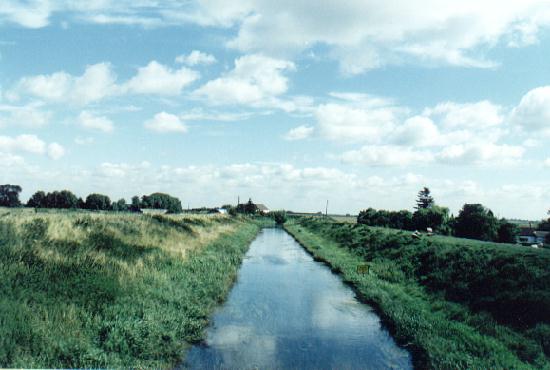
The River Glen where
it crosses the South Fen Road near Bourne
The fens are a vast, extremely flat plain bordering the Wash, a large area of mainly reclaimed land lying between Cambridge and Lincoln which today comprises some of the richest farmland in Britain, easily identified by its black soil. The last 2,000 years of its history has influenced the development of the landscape, the architecture of its abbeys, parish churches and country houses, villages and towns, natural history, industry and of course agriculture.
The Great Level, as it was once known, occupies an area of about 1,306 square miles, or 700,000 acres, in five counties of eastern England. The extreme length of fenland, from Lincoln in the north to Quy, Cambridgeshire, in the south, is 73 miles while its breadth from Brandon, Suffolk, in the east to Peterborough in the west, is approximately 36 miles. In earlier times, the place had the reputation as "a deep and horrible fen, a strange land of fetid pools and flowing rivers, and a terrain grim enough to daunt all but the most intrepid settler". The 8th century chronicler, Felix of Crowland, described it thus:
"A trackless waste of immense marshes and foul running streams." Because of its low-lying situation and the excessive damp of the region, it was "oft-times clouded with moist and dark vapours" and rumours widely prevalent at the time suggested that it was also "the haunt of devils".
In earlier times it was certainly a place of mystery, even of danger, because the inhabitants were regarded with horror by those who knew of their existence. They were condemned as brutish and their life was one of poverty-ridden squalor. Before the land was drained, those who lived there were crippled by ague, rheumatism and other bodily disorders, prone to eating opium and eking out a precarious living amid thick fogs and a permanently damp atmosphere. The opinion of the fen dwellers, however, was quite different because they saw the area as rich grazing lands, small but fertile arable fields and with abundant supplies of those things needed for survival, fish, wildfowl, sedge or turf, and this land of vast horizons also gave them something that was denied the rest of the country, namely an untrammelled freedom.
Dorothy Summers, in her excellent book The Great Level (1976), says: "According to popular report, the few scattered inhabitants almost certainly numbered among their ranks outlaws, bandits, and a half-savage race of fishers and wildfowlers. The latter are traditionally supposed to have led a semi-nomadic, amphibious life, rowing or wading from one patch of dry ground to another, a misconception which may well have given rise to the universally held belief that fenmen had webbed feet. In fact the natives, far from being a race apart, were mostly ordinary farmers."
The draining of this land, the embanking of rivers and cutting of channels, was begun by the Romans and the work has continued ever since at immense cost in human effort and money, particularly during the 17th and 18th centuries, mainly by small groups of adventurers engaged in local effort rather than an overall strategy. The highly intensive agriculture centred around the rich farm soils contrasts with the wilderness of many nature reserves, especially rich in bird and plant life, and the remoteness of the past can still be found there on still, quiet days.
|
THE
LOW FEN LANDS AND MARSHES
One
of the most important pieces of legislation to affect the Bourne
area came in 1765 with the passing of an Act for Draining and
Improving Certain Low Marsh and Fen Lands, lying between Boston
Haven and Bourne in the Parts of Kesteven and Holland in the
County of Lincoln. This provided for major engineering work in the
locality and affected practically every parish to the north east
of Bourne through which the Car Dyke passed including Morton,
Haconby, Dunsby, Dowsby, Billingborough and Horbling. The area was extensive and the work included embanking and
preserving the fens and provided for taxes to be raised on the
land involved to pay for future maintenance.
A copy of the Act
is held by Bourne Heritage Centre |
 |
But despite this ongoing development, the fen remains a region with its own individual character, flat but never featureless because there are always some trees to be seen, poplars standing like sentinels in rows along the field's edge, willows beside a river bank or clumps of older deciduous trees around an isolated farmstead, a church, or even an entire village, screening it from the winds in winter and providing shade in summer. Grassy banks cut straight across the countryside, lining the sides of the rivers or main drains, the level of which is often above that of the surrounding fields while a patchwork of smaller dykes divides the landscape into fields.
Since the elevation is so slight, the observer tends to look upwards with the result that the sky occupies more of the view than it normally does, so increasing the sense of spaciousness. It is this flatness of the landscape that gives an uninterrupted, 360-degree aspect of the horizon and on sunny days in summer, when there is a blue sky and scudding puffs of white, cumulus clouds, it is a sight to behold.
Bourne sits on the very edge of the fens but its farming prosperity is a direct result of the land drainage and the South Forty Foot Drain is a reminder of the great engineering schemes that turned this area into such productive agricultural land. Proposals to drain this area were put forward in the 17th century following the passing of the General Draining Act in 1600 and it was the Earl of Lindsey, the Lord High Chamberlain of England, who was responsible for draining much of the land to the south and west of Boston, a project that included cutting the South Forty Foot Drain, a 24-mile channel to the River Glen near Bourne, before enclosing the resulting land and building farms on it.
 |
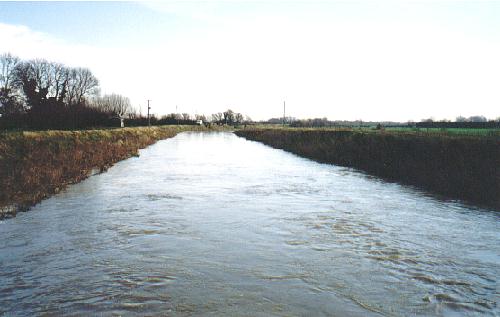 |
|
The relief channels
at Greatford (left) and Maxey (right) |
New drainage works were undertaken during the middle of the 18th century and considerable areas were freed from water for the greater part of each year. In Deeping Fen, which was mainly peat, windmills were introduced to counteract the effect of the lowered land surface and by 1763, over 50 were at work in this one fen alone. New sluices were built and channels enlarged. On the silt between the rivers Nene and Welland, each parish enclosed new areas from both sea and fen and to integrate the drainages, the South Holland Main Drain was cut in 1793-96 to carry part of the River Welland's waters direct to the sea via the River Nene.
|
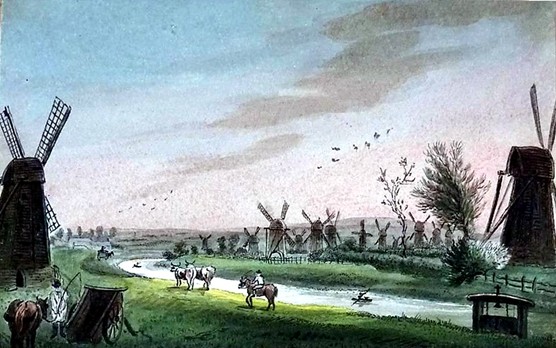 |
|
A water colour drawing by local artist Hilkiah Burgess from 1831
showing wind pumps at work in the North Drain at Deeping Fen. |
 |
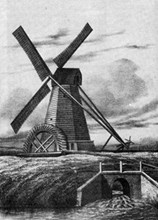 |
|
A watercolour drawing of the North Drain in
Deeping Fen (left) showing many of the windmills operating there
during the 18th century to drain the land. The drainage mill and
wheel (pictured right) is typical of those to be seen in the area
and is reproduced from A History of the Fens of South Lincolnshire
by William Wheeler published in 1868. |
Huge land areas were controlled by the windmills to drive water paddles to push water from the dykes into the drainage channels in time of heavy rainfall but these were superseded by steam engines during the 19th century.
Drainage work continues now on a regular basis. The last major scheme in the Bourne area was for the River Welland. Plans had been drawn up in 1944 but because of the Second World War, it was too late to implement them in time to prevent the disastrous floods of 1947 that affected most of the surrounding area.
The river has since been widened and deepened throughout its length from Uffington to the sea and this involved building three new cuts, the Coronation Channel at Spalding, the Maxey Cut which provides a direct channel for the automatic discharge of water which might otherwise cause flooding in the Market Deeping area, and the Greatford Cut which can be used to divert water from the River Glen into the improved River Welland below the Deepings. The building of these cuts involved the construction of several new sluices and bridges and the reconstruction of existing ones. Many miles of flood banks have also been built up and strengthened so that the washes at Cowbit and Crowland can be used as reservoirs to relieve pressure on banks elsewhere.
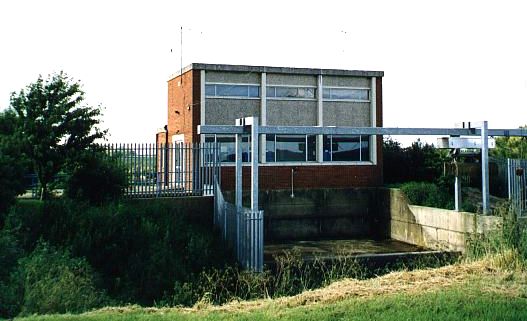
The remote-controlled pumping station at Dowsby
Fen
There are now in effect, two separate but independent drainage systems operating in the fens. The rivers embanked above the level of the surrounding land carry the water which descends from the higher ground around the fens and take it to the sea. The internal drainage system collects the rainwater that falls on the fens and feeds it into the main drains which in turn discharge into the sea. Such water has to be lifted once, sometimes twice and occasionally three times. The steam pumping engines that took over from the windmills gave way to diesel-driven pumps during the early 20th century but these have now been replaced by turbo-electric installations similar to the one at Dowsby Fen that was brought into operation in 1964. Similar pumps have been installed throughout the fens, all controlled electrically from a central point by Anglian Water, the authority that now administers land drainage in this part of South Lincolnshire.
It has taken more than 300 years to drain the fens and to provide a really effective protection against flooding in all but the most extreme of weather patterns. Today, fenland is considered to be among the best drained areas of Britain and Anglian Water continues with a programme of constant repair and renewal to ensure that the first class arable land it serves can fulfil its vital role of food production.
|
DANGER IN THE FENS |
|
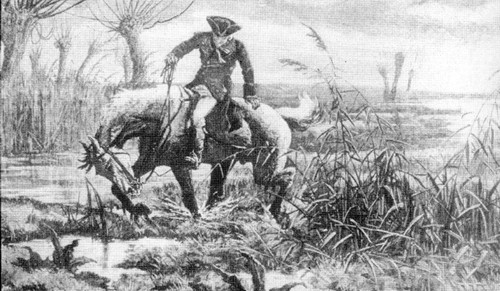 |
|
Crossing the fens could be a messy and dangerous
business. In some areas, church bells were tolled and lamps hung in
belfries to guide workers and travellers to the safety of high ground. On
occasions, livestock disappeared in bogs and people were lost. Sometimes
it was safer, but inconvenient, to make a lengthy detour rather than risk
the shortest and most difficult route.
Reproduced from Wide Horizons - Hard Graft for old-time
Fenmen by Trevor Bevis (1994). |
|
THE FEN SLODGERS |
|
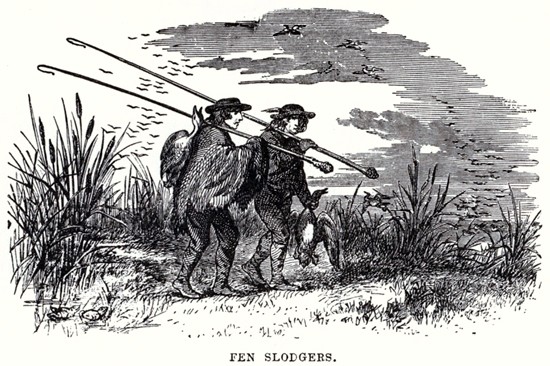 |
|
The men who lived in these desolate places were known
as fen slodgers who made their living by fishing and fowling. They lived
in huts erected on the mounds scattered among the chain of lakes which
were bordered by a thick crop of reeds, their only access to one another,
and of communication with the towns or villages near, being by means of
small boats or canoes which they paddled along with a pole, and also used
in their fishing and fowling expeditions. These men were violently opposed
to any attempts to alter the state of the fens, believing they had a kind
of vested interest in the fishing and fowling by which they gained their
scanty subsistence.
Reproduced from A History of The Fens of
South Lincolnshire
by William Henry Wheeler (1868). |
See also
Draining
of the North Fen Draining
of the South Fen
The Adventurers
Lincolnshire Yellowbellies

Go to:
Main Index Villages
Index
|









